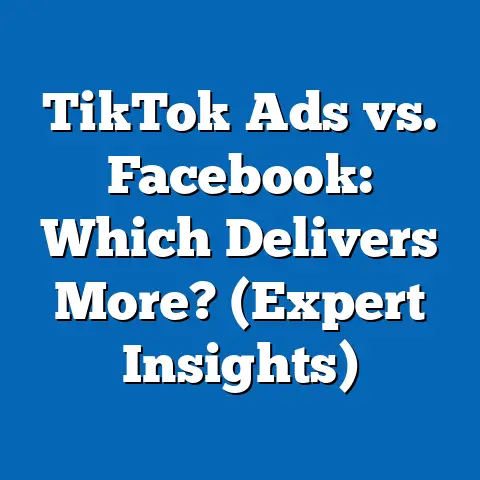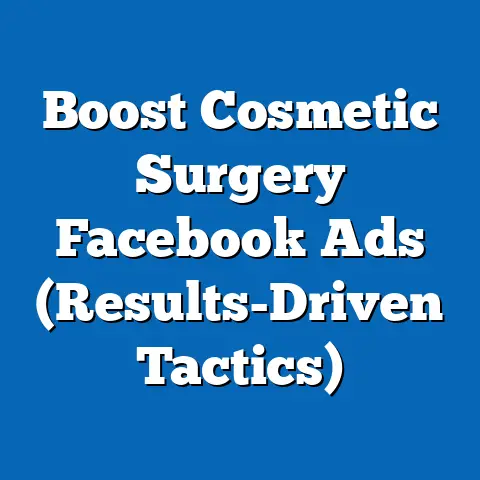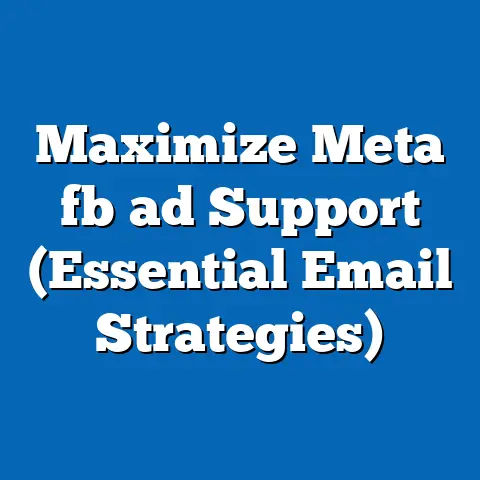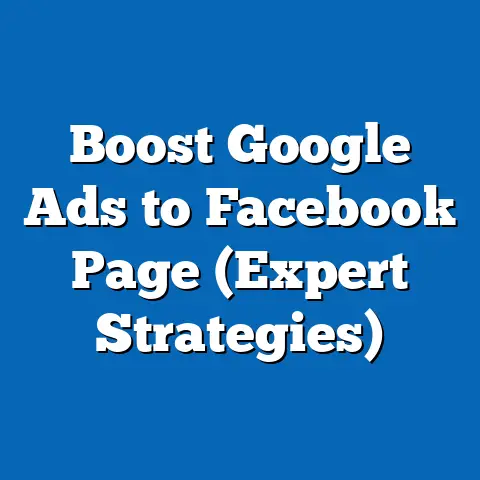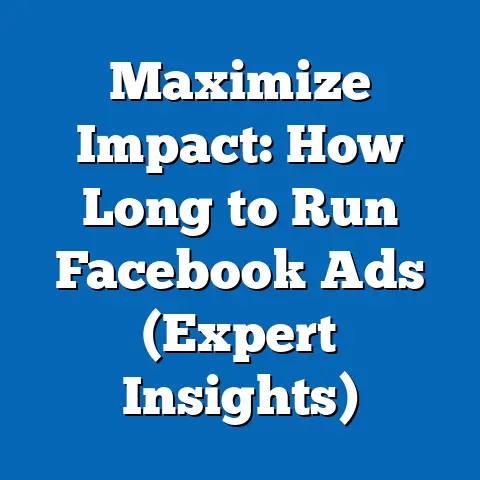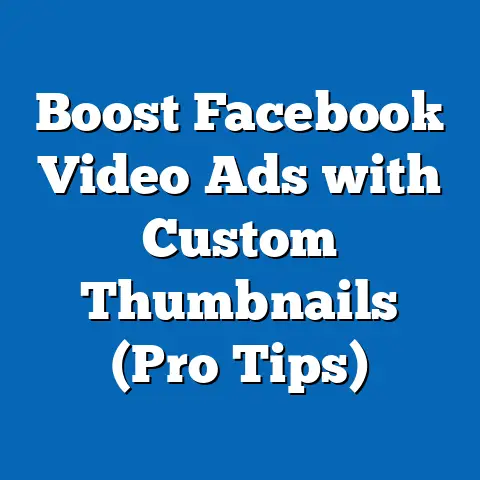Boost Conversions with Facebook Click Ad Specs (Expert Guide)
Have you ever launched a Facebook ad campaign, poured your heart and soul into crafting the perfect message, only to be met with… crickets? I’ve been there. It’s frustrating, to say the least. You might think your targeting is off, or your offer isn’t compelling enough. But what if I told you that the key to unlocking your campaign’s potential lies in something as seemingly mundane as the specifications of your Facebook Click Ads?
I know, it sounds a bit dry. But trust me, mastering these specs is the secret weapon that separates successful campaigns from those that fade into the background. According to recent data, ads that adhere to Facebook’s recommended specifications can see up to a 40% increase in engagement. That’s huge!
Facebook Click Ads are the workhorses of the digital marketing world. They’re designed to drive traffic to your website, landing page, or app, and ultimately, convert those clicks into paying customers. In this expert guide, I’m going to pull back the curtain and reveal the insider tips and strategies I’ve learned over years of managing Facebook ad campaigns, helping you optimize your ad performance and boost conversions. Get ready to transform your clicks into loyal customers!
Understanding Facebook Click Ads
Facebook Click Ads are, at their core, advertisements designed to entice users to click through to a specific destination. This could be your website, a landing page, an app store listing, or even a Facebook Messenger conversation. They’re the digital equivalent of a storefront window display, designed to capture attention and draw people inside.
There’s a surprisingly diverse range of Click Ads available on Facebook, each with its own strengths and weaknesses:
- Link Ads: These are the classic Click Ads. They feature an image or video, a headline, a short description, and a call-to-action button. They’re versatile and can be used for a wide range of marketing goals.
- Video Ads: Video is king in the digital world, and video Click Ads are no exception. They’re highly engaging and can be used to tell a story, showcase a product, or demonstrate a service.
- Carousel Ads: These ads allow you to showcase multiple images or videos in a single ad unit, each with its own headline, description, and link. They’re perfect for showcasing a range of products, highlighting different features of a single product, or telling a multi-part story.
- Collection Ads: These ads are designed to drive product discovery and sales. They feature a main video or image, followed by a selection of related products that users can browse and purchase directly from the ad.
The significance of ad specs cannot be overstated. Think of it like this: you wouldn’t try to fit a square peg into a round hole, would you? Similarly, forcing an image or video into a Facebook ad without adhering to the recommended specifications is a recipe for disaster. Incorrect specs can lead to:
- Poor Image Quality: Blurry, pixelated images are a major turn-off.
- Distorted Videos: Squashed or stretched videos look unprofessional and can damage your brand’s credibility.
- Truncated Text: Important information can be cut off, leaving users confused and uninterested.
- Reduced Reach: Facebook’s algorithm may penalize ads with incorrect specs, limiting their visibility.
- Lower Engagement: If your ad looks unprofessional or is difficult to view, users are less likely to click on it.
Ultimately, ignoring ad specs can lead to lower conversion rates and wasted ad spend. That’s why understanding and adhering to these guidelines is crucial for maximizing the effectiveness of your Facebook advertising campaigns.
Key Takeaway: Facebook Click Ads are diverse and powerful tools for driving traffic and conversions. Adhering to the recommended specifications is essential for ensuring optimal ad performance and avoiding costly mistakes.
I know, it might seem a bit overwhelming at first, but trust me, once you get the hang of it, it becomes second nature. I’ve compiled a list of the most essential Facebook Click Ad specs that you need to know to create high-performing ads:1. Image Specifications:
- Image Dimensions: This is the size of your image, measured in pixels (width x height). Different ad placements have different recommended dimensions. For example, a single image ad in the Facebook feed typically requires an image that’s 1200 x 628 pixels. I personally like to use square images (1080×1080) for most placements, as they adapt well across different devices and placements.
- File Size: Facebook recommends keeping your image file size under 30MB for optimal loading speed. Larger files can slow down your ad and lead to a poor user experience.
- File Format: The recommended file formats are JPEG and PNG. JPEG is generally preferred for photographs, while PNG is better for graphics with sharp lines and text.
- Aspect Ratio: This is the ratio of the image’s width to its height. For example, a square image has an aspect ratio of 1:1, while a landscape image might have an aspect ratio of 16:9.
- Text Overlay: Facebook used to have a strict “20% text rule,” which limited the amount of text you could include in your ad image. While this rule is no longer in effect, it’s still a good idea to keep your text to a minimum. Images with less text tend to perform better.
2. Video Specifications:
- Video Length: Facebook allows videos up to 240 minutes long, but shorter videos tend to perform better. I recommend keeping your videos under 15 seconds for optimal engagement.
- Video Aspect Ratio: The recommended aspect ratios are 1:1 (square), 4:5 (vertical), and 9:16 (full-screen vertical). Vertical videos are particularly effective on mobile devices.
- Video Resolution: Aim for a resolution of at least 1080p (1920 x 1080 pixels) for clear, high-quality videos.
- File Size: The maximum file size for videos is 4GB.
- File Format: The recommended file formats are MP4 and MOV.
- Captions: Adding captions to your videos is crucial, as many users watch videos with the sound off.
3. Text Specifications:
- Headline: This is the main text that appears at the top of your ad. It should be concise, attention-grabbing, and relevant to your target audience. The recommended length is 25 characters.
- Primary Text: This is the longer text that appears above your ad image or video. It should provide more details about your offer and encourage users to click. The recommended length is 125 characters.
- Description: This is the text that appears below your ad image or video. It should provide additional context and reinforce your call to action. The recommended length is 30 characters.
- Call-to-Action Button: This is the button that encourages users to take a specific action, such as “Shop Now,” “Learn More,” or “Sign Up.” Choose a call-to-action that is relevant to your offer and your marketing goals.
Visual Examples:
- Correct Use: An ad featuring a high-quality image with the recommended dimensions, minimal text overlay, a concise headline, and a clear call-to-action button.
- Incorrect Use: An ad featuring a blurry, pixelated image with incorrect dimensions, excessive text overlay, a lengthy headline, and a generic call-to-action button.
How do these specifications affect ad visibility and engagement? Simple. Ads that adhere to Facebook’s recommended specifications are more likely to be shown to a wider audience and to receive higher engagement rates. This is because Facebook’s algorithm favors ads that provide a positive user experience. By using high-quality images and videos, writing concise and compelling text, and choosing a relevant call-to-action, you can increase the chances of your ad being seen and clicked on by your target audience.
Key Takeaway: Mastering Facebook Click Ad specs is essential for creating high-performing ads that capture attention, drive engagement, and boost conversions. Pay close attention to image dimensions, video specifications, and text limits to ensure your ads look professional and provide a positive user experience.
The Psychology Behind Effective Click Ads
Now that we’ve covered the technical aspects of Facebook Click Ads, let’s delve into the psychology behind what makes them truly effective. Understanding the psychological factors that influence user engagement can help you create ads that resonate with your target audience and drive conversions.
- Color Psychology: Colors evoke different emotions and associations. For example, blue is often associated with trust and reliability, while red is associated with excitement and urgency. Choose colors that align with your brand’s identity and the message you’re trying to convey. I’ve found that using contrasting colors can also help your ad stand out in the crowded Facebook feed.
- Emotional Triggers: Appealing to emotions can be a powerful way to connect with your target audience. Consider using images and text that evoke feelings of happiness, excitement, fear, or nostalgia. For example, an ad for a travel agency might feature stunning images of exotic destinations to evoke feelings of wanderlust.
- Social Proof: People are more likely to take action if they see that others have already done so. Include testimonials, reviews, or social media mentions in your ads to build trust and credibility. I often use ad copy that highlights the number of satisfied customers or the positive results that others have achieved.
- Scarcity: Creating a sense of scarcity can motivate users to take action quickly. Use phrases like “Limited Time Offer” or “While Supplies Last” to encourage users to click and convert before it’s too late.
- Personalization: Tailoring your ads to individual users based on their interests, demographics, and behavior can significantly increase engagement. Use Facebook’s targeting options to create highly personalized ads that resonate with your target audience.
How does aligning ad specs with psychological principles lead to higher click-through rates (CTR) and conversions? It’s all about creating a seamless and engaging user experience. When your ad looks visually appealing, evokes the right emotions, and provides a clear call to action, users are more likely to click and convert.
For example, imagine you’re selling a weight loss program. You could create an ad featuring a before-and-after photo of a satisfied customer, along with text that highlights the emotional benefits of losing weight (e.g., increased confidence, improved health). By aligning the ad specs with psychological principles, you can create a compelling ad that resonates with your target audience and drives conversions.
Key Takeaway: Understanding the psychology behind effective Click Ads can help you create ads that resonate with your target audience and drive conversions. Consider using color psychology, emotional triggers, social proof, scarcity, and personalization to create compelling ads that capture attention and encourage action.
Best Practices for Crafting High-Converting Click Ads
Now that we’ve covered the technical and psychological aspects of Facebook Click Ads, let’s move on to the practical side of things. Here are some best practices for crafting high-converting Click Ads that adhere to Facebook’s specs and drive results:
- Know Your Audience: Before you start creating your ads, take the time to understand your target audience. What are their interests, demographics, and behaviors? What are their pain points and aspirations? The more you know about your audience, the better you can tailor your ads to their needs and preferences.
- Write Compelling Copy: Your ad copy should be clear, concise, and attention-grabbing. Highlight the benefits of your offer and use persuasive language to encourage users to click. I always start with a strong headline that grabs attention and then follow up with a brief description that explains the value proposition.
- Use High-Quality Visuals: Your ad image or video should be visually appealing and relevant to your offer. Use high-resolution images and videos that are properly sized and formatted for Facebook.
- Create a Clear Call to Action: Your call to action should be clear and concise, telling users exactly what you want them to do. Use action-oriented verbs like “Shop Now,” “Learn More,” or “Sign Up.”
- A/B Test Your Ads: A/B testing involves creating multiple versions of your ad and testing them against each other to see which one performs best. Test different headlines, images, text, and call-to-actions to see what resonates with your target audience. I’ve found that A/B testing is the most effective way to optimize my ad campaigns and improve my results.
- Monitor Your Results: Keep a close eye on your ad performance and make adjustments as needed. Track key metrics like CTR, conversion rate, and cost per conversion to see how your ads are performing.
- Stay Up-to-Date: Facebook is constantly changing its ad specs and best practices. Stay up-to-date on the latest changes and adjust your ads accordingly.
The importance of A/B testing cannot be overstated. It’s the only way to know for sure what resonates with your target audience. I recommend testing at least two different versions of your ad at a time, changing only one element at a time (e.g., headline, image, text). This will allow you to isolate the impact of each element and determine what works best.
The role of clear calls to action (CTAs) is also crucial. Your CTA should be tailored to match your ad specs and audience expectations. For example, if you’re promoting a product, use a CTA like “Shop Now” or “Add to Cart.” If you’re promoting a service, use a CTA like “Learn More” or “Get a Free Quote.”
Key Takeaway: Crafting high-converting Click Ads requires a combination of technical expertise, psychological understanding, and best practices. Know your audience, write compelling copy, use high-quality visuals, create a clear call to action, A/B test your ads, monitor your results, and stay up-to-date on the latest changes.
Measuring Success: Analyzing Click Ad Performance
Creating effective Facebook Click Ads is only half the battle. You also need to be able to measure your success and make adjustments as needed. Fortunately, Facebook Ads Manager provides a wealth of data that you can use to track your ad performance and optimize your campaigns.
Here are some key performance metrics to track:
- Click-Through Rate (CTR): This is the percentage of users who click on your ad after seeing it. A high CTR indicates that your ad is relevant and engaging to your target audience.
- Conversion Rate: This is the percentage of users who take a desired action (e.g., make a purchase, sign up for a newsletter) after clicking on your ad. A high conversion rate indicates that your landing page is effective and that your offer is compelling.
- Cost Per Click (CPC): This is the amount you pay each time someone clicks on your ad. A low CPC indicates that your ad is efficient and that you’re targeting the right audience.
- Cost Per Conversion (CPC): This is the amount you pay each time someone takes a desired action after clicking on your ad. A low CPA indicates that your ad campaign is profitable.
- Return on Ad Spend (ROAS): This is the amount of revenue you generate for every dollar you spend on advertising. A high ROAS indicates that your ad campaign is generating a significant return on investment.
How do you use Facebook Ads Manager to analyze performance data effectively? Start by setting up custom columns in Ads Manager to track the metrics that are most important to you. Then, use the filtering and reporting options to segment your data and identify trends.
For example, you might want to filter your data by age, gender, or location to see which demographics are responding best to your ads. You might also want to compare the performance of different ad placements (e.g., Facebook feed, Instagram feed, Audience Network) to see which ones are generating the best results.
The importance of adjusting ad specs based on performance insights cannot be overstated. If you notice that your CTR is low, try testing different headlines, images, or text. If you notice that your conversion rate is low, try improving your landing page or offering a more compelling incentive.
Remember, Facebook advertising is an ongoing process of testing, measuring, and optimizing. By continuously analyzing your ad performance and making adjustments as needed, you can improve your results and drive more conversions.
Key Takeaway: Measuring your success is essential for optimizing your Facebook Click Ads and driving conversions. Track key performance metrics, use Facebook Ads Manager to analyze your data, and adjust your ad specs based on performance insights.
Conclusion
We’ve covered a lot of ground in this expert guide, from understanding the basics of Facebook Click Ads to mastering the technical specs, psychological principles, best practices, and performance metrics. I hope you’ve found this information helpful and that you’re now better equipped to create high-converting Facebook ads that drive results.
Remember, the secret to transforming clicks into loyal customers lies in mastering the art of Facebook Click Ads. Pay close attention to the details, test different approaches, and continuously optimize your campaigns based on performance insights.
So, are you ready to elevate your advertising game? Take the insights shared in this article and experiment with your ad campaigns. I’m confident that you’ll see a significant improvement in your results.
Now go out there and start converting those clicks into loyal customers! The world of Facebook advertising awaits, and with the knowledge you’ve gained here, you’re well on your way to success.

